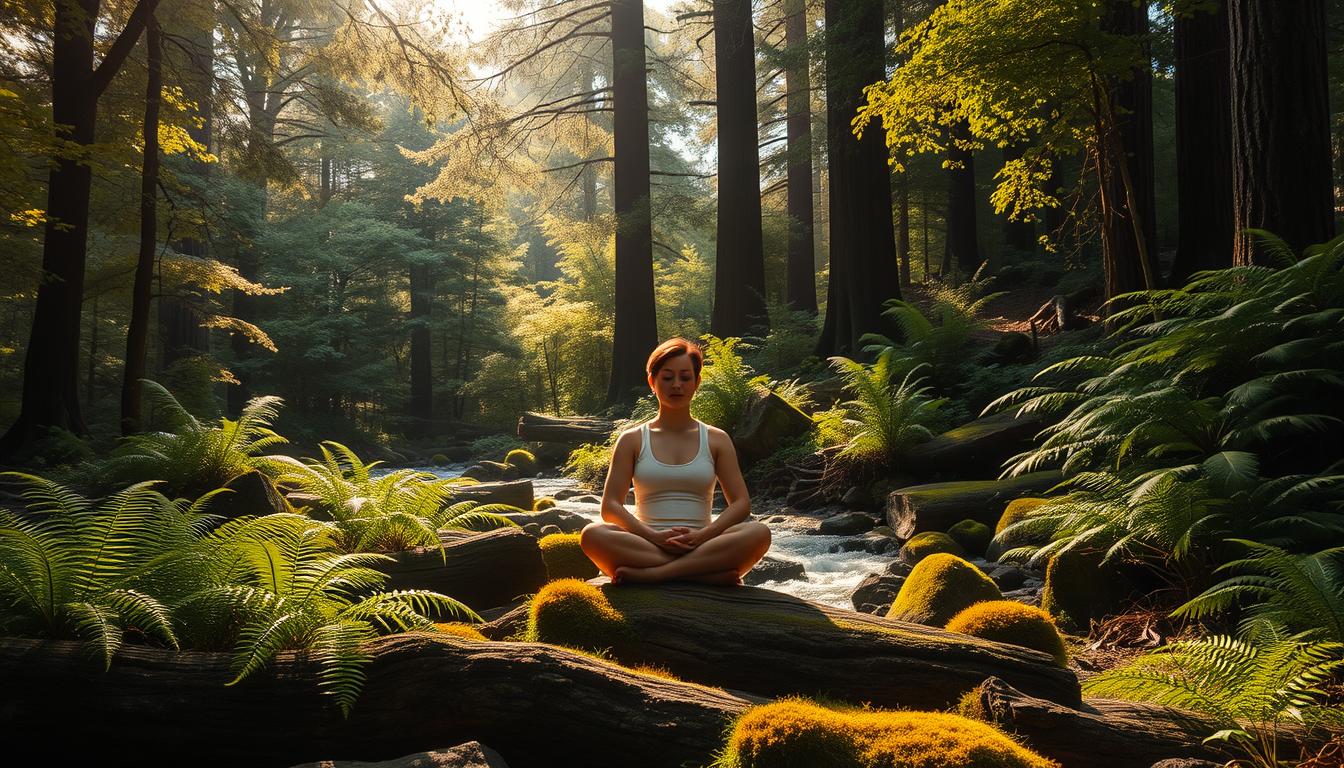isn’t just for experts. It’s a tool for everyone to use in daily life. It helps you stay focused on the present moment. This guide makes mindfulness for beginners easy to follow.
Millions worldwide have seen its benefits. They’ve experienced less stress and better focus. It’s a practice for anyone.
“Mindfulness is awareness,” says Jon Kabat-Zinn, founder of Mindfulness-Based Stress Reduction. It’s about watching your thoughts without judgment. You don’t need to empty your mind. No special skills or beliefs are needed—just curiosity.
Science backs its benefits. It shows even small daily practices can change how we face challenges.
Key Takeaways
- Mindfulness improves mental clarity and emotional balance.
- No prior experience is needed to start mindfulness for beginners.
- Research supports its role in lowering stress and enhancing well-being.
- Simple techniques like breathing exercises are easy to incorporate into daily routines.
- This guide offers actionable steps to build a consistent practice.
What is Mindfulness? Understanding the Foundation
Mindfulness is about being fully present and aware. It combines ancient wisdom with modern science. This helps build resilience and clarity.
The Ancient Origins of Mindfulness Practices
Mindfulness started over 2,500 years ago in Buddhist traditions like Vipassana and Zazen. Monks focused on breath and living ethically. In the 1970s, Dr. Jon Kabat-Zinn made it more accessible with Mindfulness-Based Stress Reduction (MBSR).
Now, workplaces and schools use it to boost mental health.
How Mindfulness Differs from Meditation
- Mindfulness is about being aware in everyday life—like eating or walking.
- Meditation is a specific way to practice awareness, like sitting quietly.
- Both are important but different. For example, mindful breathing while walking combines movement with focus.
The Science Behind Mindful Awareness
Studies show mindfulness changes the brain. Harvard and the University of Massachusetts found it increases gray matter in areas for memory and empathy. Neuroscientists like Richard Davidson have found it reduces stress in the brain.
This shows mindfulness is not just a philosophy—it’s supported by science.
The Transformative Benefits of Mindfulness
The benefits of mindfulness are real and backed by science. It helps lower stress hormones, which can improve blood pressure and boost the immune system. Studies show that after eight weeks of daily mindfulness, people sleep 15% better.
- Physical health: Harvard research links mindfulness to lower inflammation, easing chronic pain and improving heart health.
- Mental clarity: Anxiety and depression symptoms drop by 30% with consistent practice, per a 2023 JAMA study.
- Brainpower: MRI scans reveal thicker prefrontal cortexes in practitioners, sharpening focus and memory.
- Social connections: Enhanced empathy and active listening skills foster stronger relationships and workplace collaboration.
“Mindfulness isn’t just a trend—it’s a tool that reshapes how we interact with ourselves and others.”
Long-term, mindfulness helps us face life’s challenges better and find more purpose. It improves well-being at work, home, and in personal growth. Small daily steps lead to big improvements, showing mindfulness is a mindset shift.
Getting Started: Core Mindfulness Techniques for Beginners
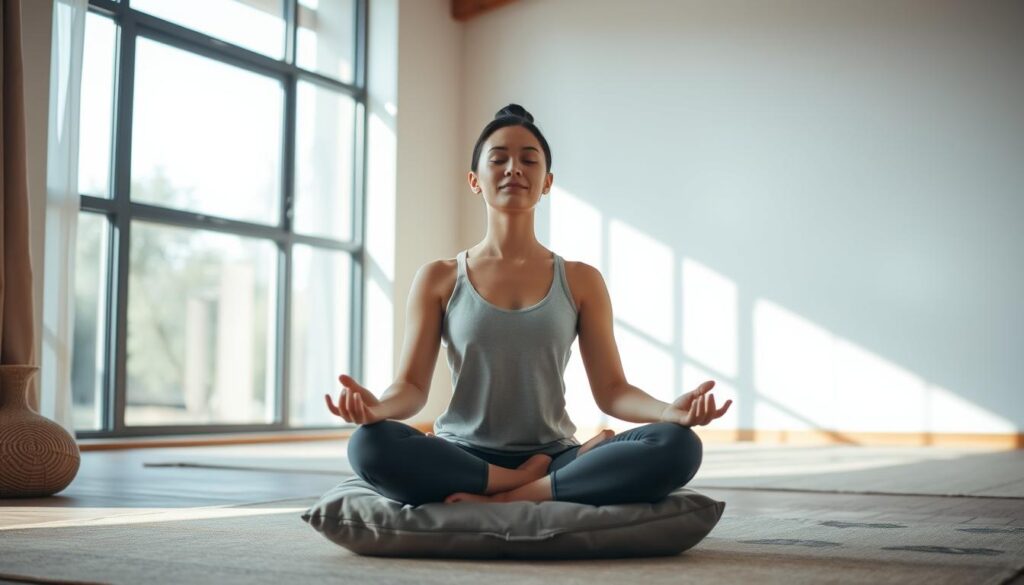
Starting with mindfulness is easy. You just need simple, repeatable practices. These four foundational mindfulness techniques are easy to use and accessible right away. They help you create a regular routine.
Mindful Breathing Exercises
Start with the 4-7-8 technique:
- Inhale quietly through your nose for 4 seconds
- Hold breath for 7 seconds
- Exhale slowly through pursed lips for 8 seconds
Do this for 3–5 minutes. Mindfulness exercises like this keep you in the moment. If your mind drifts, just bring it back to your breath.
Body Scan Meditation
Find a comfortable spot and pay attention to your body from toes to head. Start with your feet, noticing any sensations without judgment. Do this for 10–15 minutes each day. Apps like Headspace or Calm can guide you. Regular practice improves your body awareness and lowers muscle tension.
Mindful Observation Practice
Choose something simple like a leaf, pen, or kitchen sponge. Look at its shape, texture, and color for 1–2 minutes without thinking about it. This exercise helps you notice the world in a new way. You’ll find details like a leaf’s veins become clearer when you’re curious.
Loving-Kindness Meditation
Sit quietly and say to yourself:
“May I be safe. May I be healthy.”
Then, wish the same for others, starting with those close to you. Gradually include more people. Begin with 5–10 minutes a day to grow empathy and reduce self-criticism.
| Technique | Focus Area | Duration |
|---|---|---|
| Mindful Breathing | Breath rhythm | 3–5 min |
| Body Scan | Somatic awareness | 10–15 min |
| Mindful Observation | Object details | 1–2 min |
| Loving-Kindness | Compassion | 5–10 min |
Do these mindfulness exercises 5–7 days a week. Regular practice strengthens your ability to stay present. Don’t worry about being perfect. Just focus on being there.
Integrating Mindfulness into Your Daily Routine
Building a mindful life doesn’t need more time—it needs focus. Small, regular mindfulness practices can make a big difference. Start by turning everyday moments into chances for calm and focus.
Morning Mindfulness Rituals
Start your day with a clear purpose:
- Wakeful breathing: Take 3 deep breaths when you wake up, feeling the air move in and out.
- Gratitude journaling: Write down 1-2 things you’re thankful for, no matter how short.
- Stretch with awareness: Spend 5 minutes on yoga or stretches, noticing each muscle’s movement.
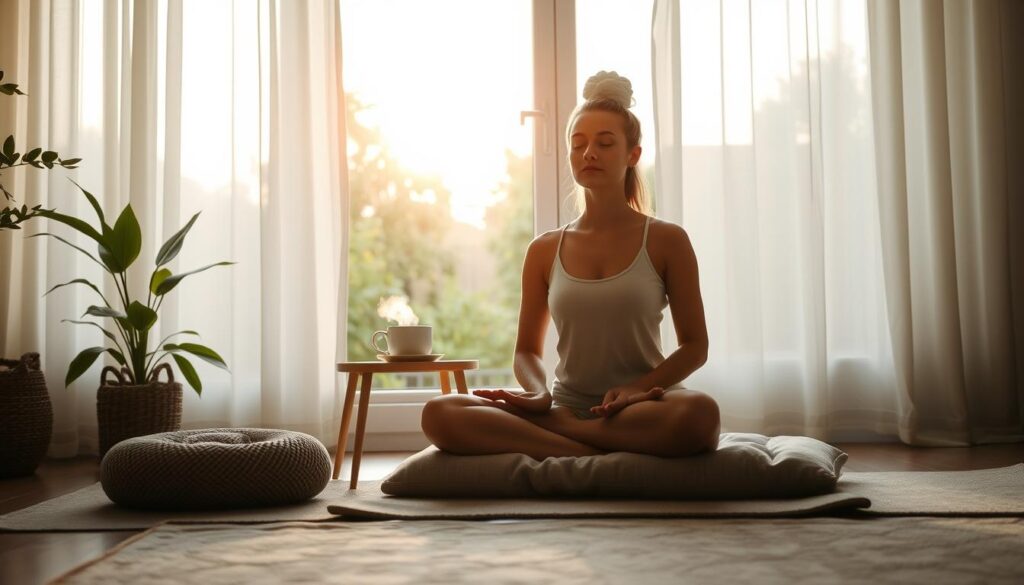
Mindful Eating Practices
Eat with care by:
- Turning off screens and eating at a table
- Chewing slowly to enjoy the taste and texture
- Checking if you’re still hungry every 3 bites to avoid eating too much
“The point is not to eat perfectly, but to eat with presence.” – Jon Kabat-Zinn
Mindfulness at Work
Stay focused during busy times with:
- Transition pauses: Take 5 seconds between tasks to refocus
- Desk micro-breaks: Breathe deeply for 1 minute when stressed
- Active listening: Repeat key points silently during meetings to stay engaged
Just 10 seconds of mindful breathing when an email comes in can keep you present. It’s the regular practice, not how long, that makes these habits stick.
Mindfulness for Stress Relief and Anxiety Management
Stress makes our body react as if we’re in danger, releasing cortisol and adrenaline. Mindfulness helps by keeping us in the present. It teaches us to watch our thoughts without judgment, easing anxiety’s hold.
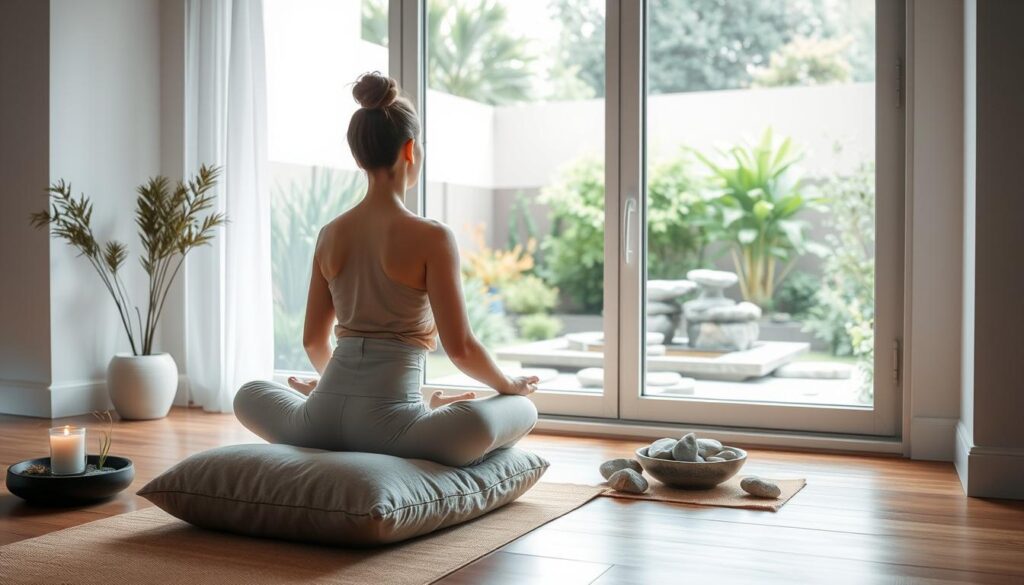
- Stop: Pause whatever you’re doing.
- Take a breath: Inhale deeply for 4 counts, exhale for 6.
- Observe: Note physical sensations and emotions without reacting.
- Proceed: Choose a calm response.
For grounding, try the 5-4-3-2-1 technique. Name 5 things you see, 4 sensations felt, 3 sounds heard, 2 smells detected, and 1 object you can touch. It helps shift your focus to the present.
“Mindfulness isn’t about emptying the mind—it’s about training attention.”
Studies show mindfulness can reduce anxiety by 30% in just 8 weeks (JAMA Psychiatry, 2022). It can also prevent anxiety relapse by 43% compared to others. Remember, these are tools, not a replacement for professional help.
Use these techniques before meetings, during breaks, or in family disagreements. Small daily efforts can build your resilience. Your breath is always a tool to find calm.
Common Obstacles in Mindfulness Practice and How to Overcome Them
Starting with mindfulness can be tricky. You might face unexpected challenges. But, these are normal and part of the journey, not failures. Let’s find ways to keep moving forward.
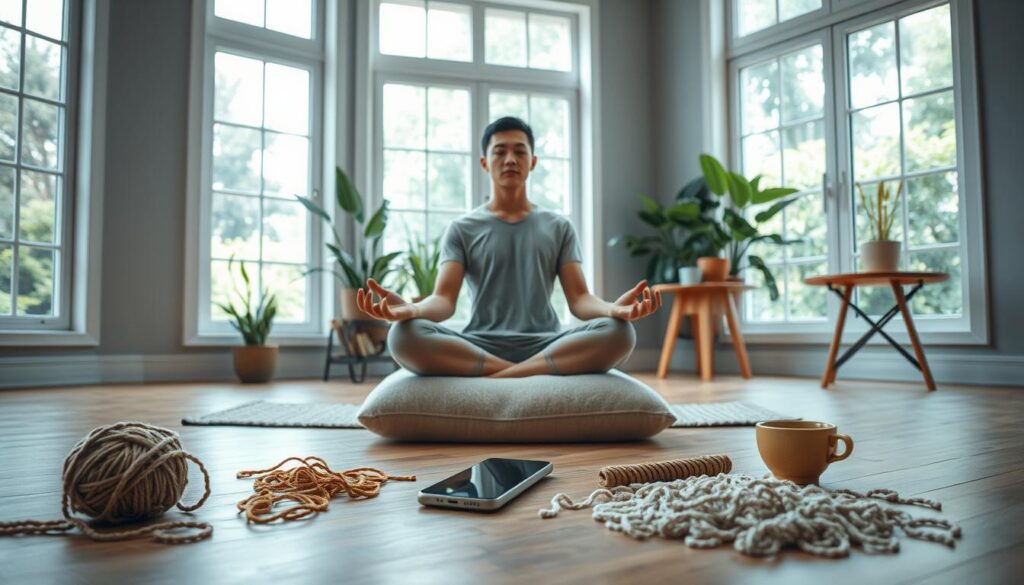
“The mind’s wanderings are natural—each return to focus is progress,” says mindfulness pioneer Jon Kabat-Zinn.
| Obstacle | Solution | Example |
|---|---|---|
| Wandering Mind | Gentle redirection | Label thoughts as “thinking” and return to breath |
| Time Constraints | Micro-moments | 30-second mindful breathing during commutes |
| Unrealistic Goals | Progress tracking | Weekly journal entries noting small wins |
Dealing with a Wandering Mind
Thoughts wandering is common in mindfulness. Here are some tips::
- Notice when thoughts wander, then gently return to your breath
- Use apps like Headspace or Calm for guided practice
- Try a 1-minute timer to help stay focused
Finding Time for Practice
Even busy lives have small moments for mindfulness::
- Practice mindfulness during daily routines, like after brushing your teeth
- Take short pauses during work breaks
- Adjust the length of your practice when life gets busy
Managing Expectations and Progress
Success in mindfulness isn’t about stopping thoughts right away. Try these tips::
- Write down insights in a journal each week
- Celebrate noticing distractions as mindfulness wins
- Focus on being consistent, not perfect
Remember, every mindful moment is valuable. Progress isn’t always straight, but each effort makes you stronger. Be kind to yourself as you grow.
Advanced Mindfulness Practices to Explore as You Progress
As you get better at mindfulness, try these advanced practices. They help deepen your focus and awareness. Mindfulness meditation and techniques grow as you become more confident.

Walking Meditation
Walking meditation makes walking a mindful ritual. Move slowly, feeling each step. Keep your eyes softly down, watching your breath and steps.
Try these variations:
- Urban practice: Walk mindfully in busy places, noticing sounds without judgment.
- Nature-based: Use your senses in nature, like feeling grass or wind.
Mindful Movement and Yoga
Combine physical activity with mindfulness for full benefits. Yoga poses like Tree Pose or Child’s Pose help blend breath and movement. Tai chi and qigong also add mindful awareness to smooth motions.
Begin with 10-minute sessions. Focus on alignment and breathing together.
Extended Silent Retreats
Retreats provide deep mindfulness experiences. Here’s a comparison of retreat types and benefits:
| Type | Duration | Benefits | Challenges |
|---|---|---|---|
| Day-long | 8–12 hours | Enhanced focus | Initial restlessness |
| Week-long | 5–7 days | Deepened insight | Emotional release |
| Multi-week | 2 weeks+ | Transformative clarity | Physical discomfort |
Go at your own pace. Advanced practices increase awareness but need patience and curiosity, not perfection.
Recommended Resources: Books, Apps, and Communities for Mindfulness Practitioners
Listen to genius sound waves and be smarter than you think!
“Mindfulness is paying attention in a particular way: on purpose, in the present moment, and non-judgmentally.” — Jon Kabat-Zinn
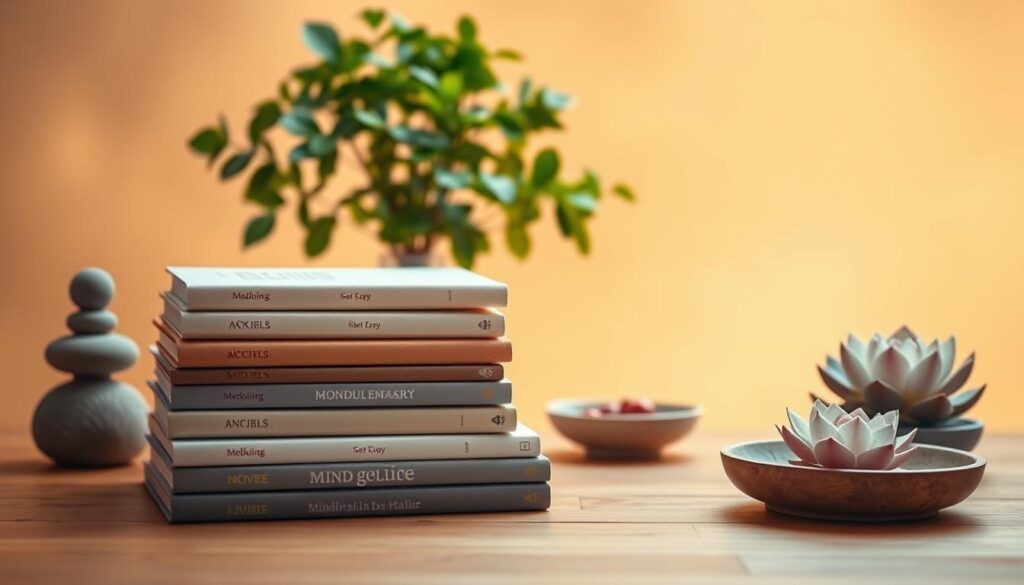
Start your mindfulness journey with these trusted resources. Begin with Mindfulness in Plain English by Bhante Gunaratana. It breaks down the basics. For a 28-day program, try Real Happiness by Sharon Salzberg. Books
Full Catastrophe Living by Kabat-Zinn is great for managing stress.
- Mindfulness in Plain English – Clarifies foundational concepts for beginners.
- Wherever You Go, There You Are – Kabat-Zinn’s classic on daily application.
- 10% Happier: How Meditation Changed My Life – Dan Harris blends skepticism and science.
Apps like Headspace and Insight Timer are great for daily practice. Stop, Breathe & Think offers mood-based exercises.
- Headspace – Guided meditations and sleep sounds (paid).
- Calm – Includes mindfulness for kids and work-life balance.
- Insight Timer – Free sessions with a global community.
Join local groups on Meetup or attend retreats at Spirit Rock (California) or Insight Meditation Society (MA). The Institute for Mindfulness-Based Approaches offers teacher training.
Choose resources that fit your goals. Whether books, apps, or retreats, these tools support your mindfulness journey.
Conclusion: Your Journey to Mindful Living Starts Now
Starting a mindfulness practice today is the first step towards lasting change. You’ll see benefits like less stress and better focus. Just a few minutes of mindful breathing or meditation can change your view and build strength.
Studies show mindfulness helps with emotional balance and clarity. Apps like Headspace or Insight Timer help beginners. Online groups, like the UCLA Mindful Awareness Research Center, offer more resources. It’s not about being perfect—it’s about showing up every day, even when it’s hard.
Start where you are. Try focusing on your breath for five minutes. Or try the body scan technique. Every practice, no matter how short, helps your well-being grow. Over time, these moments lead to more awareness and calm in your life.
Mindfulness is a journey, not a quick fix. Learn and grow with each session. Share your journey with others or keep a journal. Every step, big or small, brings you closer to peace and clarity.
Today is the day to begin. Open an app, find a quiet spot, or just pause and breathe. The journey to mindful living starts now. Every breath you take moves you closer to a stronger, more mindful you.
Listen to genius sounds waves and be smarter than you think!
